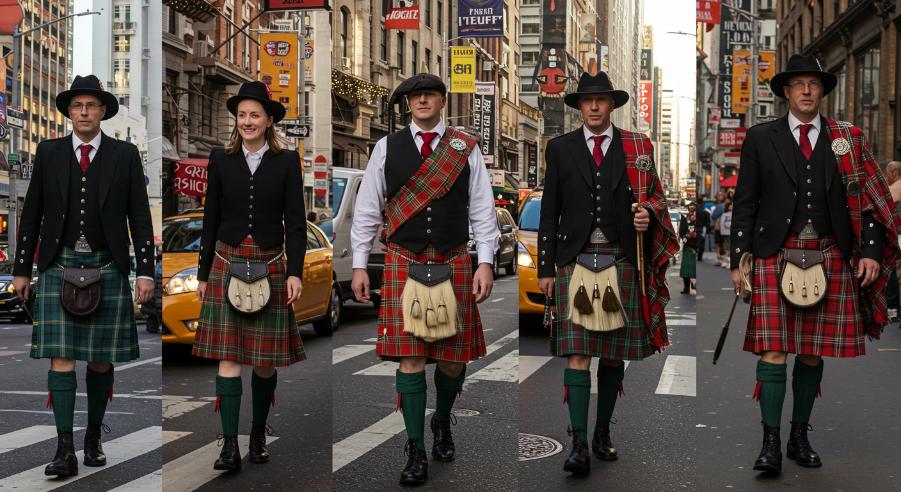Beyond Scotland: Unexpected Places Where Kilts Are Popular Today

The kilt, a garment most closely associated with the Highlands of Scotland, has long been a symbol of tradition, heritage, and national pride. Initially designed for practicality and comfort, the kilt has become more than just a piece of clothing. Over the centuries, this iconic garment has traveled far beyond the borders of Scotland, gaining recognition and popularity in many unexpected corners of the world. Today, the kilt is embraced in various countries as a nod to Scottish heritage and a unique fashion statement.
In this blog, we'll explore some places where kilts have made their mark, surprising many with their versatility and global appeal.
1. The United States: A Blend of Tradition and Modern Fashion
Kilts have a long-standing presence in the United States, primarily due to the Scottish diaspora. Scottish Americans, particularly in cities like New York, Boston, and Chicago, wear kilts to connect with their heritage, especially during cultural events like the Tartan Day Parade or Scottish festivals. In addition, cities across the country host the Highland Games, where kilts are worn by competitors, performers, and spectators alike.
Beyond these cultural celebrations, kilts have also found a place in American fashion. In major metropolitan areas such as New York and Los Angeles, kilts have been embraced by alternative fashion communities. Streetwear designers and stylists are incorporating kilts into their collections, making them a bold choice for anyone wanting to make a distinctive fashion statement. While Scottish heritage is often the primary reason for wearing a kilt, many people in the U.S. are now donning them as part of broader fashion trends.
2. Canada: A Shared History and Cultural Connection
The kilt's popularity in Canada mirrors that of its southern neighbor, the United States. The country has a rich Scottish history, especially in provinces like Nova Scotia and Quebec, where large Scottish communities settled in the 18th and 19th centuries. In these areas, kilts are worn during cultural celebrations, including Tartan Day and Highland Games, where people gather to celebrate Scottish things.
In larger cities like Toronto and Vancouver, kilts have also found a place in everyday fashion. For some, wearing a kilt expresses Canadian pride, especially in regions where Scottish heritage is still deeply intertwined with local culture. Kilts are worn by those participating in community parades, cultural events, or even just as a personal style choice.
3. Ireland: A Shared Celtic Connection
Ireland and Scotland share a deep cultural bond through their Celtic roots, extending to the kilt. Though the kilt is more traditionally associated with Scotland, many Irish people have adopted the garment, especially for occasions such as St. Patrick's Day, Celtic music festivals, and Irish weddings. Irish-Americans in places like Boston, Chicago, and New York have helped bring the kilt into mainstream culture, often pairing it with their Irish heritage.
Kilts are also seen in Irish dance and other Celtic performances. The combination of traditional Irish attire and the Scottish kilt creates a blend of Celtic culture that has become a staple of various festivities.
4. New Zealand: A Fusion of Tradition and Sport
In New Zealand, kilts are not just for ceremonial or cultural purposes—they are also linked to the country's love for sports, particularly rugby. While New Zealand has no long-standing history with kilts like Scotland or Canada, the garment has gained popularity, especially among rugby fans and athletes. New Zealand rugby fans, often seen wearing kilts at games and fan events, have embraced this symbol of rugged masculinity and cultural pride.
Kilts are also worn during the New Zealand Highland Games, where participants compete in events like the caber toss and tug-of-war, sporting traditional attire, including the kilt. The garment seamlessly fits into New Zealand's sporting culture, blending tradition with a love for competition.
5. Australia: A Modern Twist on a Classic Garment
The kilt is often worn in Australia as part of various Scottish festivals and Celtic-themed events. The influence of Scottish and Irish immigrants, along with the country's growing interest in world cultures, has increased kilts' popularity. In cities like Sydney, Melbourne, and Brisbane, kilts are seen during St. Andrew's Day celebrations, Highland Games, and other cultural gatherings.
Kilts are also becoming popular in Australia, particularly among alternative fashion enthusiasts. The modern twist on the traditional kilt scottish—such as leather kilts or utility kilts—has made it a flexible and stylish garment. Whether worn for a formal event or as part of a casual outfit, kilts make a statement in Australian fashion.
6. Germany: A Surprising Adoption of Scottish Culture
One of the more surprising places where kilts have gained popularity is Germany. Known for its deep-rooted traditions, Germany has adopted elements of Scottish culture, particularly in areas like Bavaria, where Oktoberfest is celebrated with a fusion of Celtic and Germanic customs. Kilts and lederhosen are often worn during Oktoberfest festivities and other German celebrations that highlight international culture.
In cities like Berlin, Scottish festivals have become an annual tradition, and kilts are commonly worn by locals and tourists alike. Additionally, alternative fashion scenes in Germany have embraced kilts as part of punk or Gothic fashion, making them prominent garments in subcultures that value uniqueness and individuality.
7. Japan: The Cultural Intersection of East and West
Kilts have found their way into Japan, particularly among fashion-forward individuals in cities like Tokyo. The influence of global fashion trends and subcultures has made the kilt an unexpected yet exciting addition to the wardrobes of many Japanese citizens. Kilts are often worn during Celtic music festivals or other events where Scottish culture is celebrated.
What is truly fascinating about Japan's adoption of the kilt is the fusion of traditional Scottish attire with Japanese aesthetics. Some Japanese fashion designers have even incorporated kilts into their collections, creating unique hybrid styles that blend Western and Eastern influences.
8. South Korea: The Rise of Global Fashion
In South Korea, the kilt has gained a following among younger generations, particularly those interested in Western fashion trends. With its growing reputation as a global fashion hub, Seoul is one of the places where kilts have found their niche. Whether worn for fashion purposes or during cultural events, the kilt has been embraced as a unique way to make a statement.
In South Korea, Scottish kilts are often worn as part of a broader trend toward eclectic, alternative fashion, particularly in streetwear. The fusion of traditional Scottish clothing with modern materials and designs has made the kilt a trendy and functional garment for those who want to stand out.
9. Kilts in the Military and Other Professions
Kilts have also found a place in various professions worldwide, especially in ceremonial contexts. The Scottish military has long worn kilts as part of their uniform, and this tradition is maintained in Scotland and other countries with strong ties to the UK. For instance, Canada and New Zealand have military regiments that wear kilts as part of their official ceremonial dress.
Kilts are also worn in professions like bartending and catering in certain regions. The rugged, functional design of utility kilts makes them popular for professionals needing comfort and style while working.
Conclusion
Kilts have come a long way from their origins in the Scottish Highlands. From their traditional role as a symbol of Scottish identity to their adoption in unexpected places worldwide, kilts have become a garment that transcends culture, fashion, and even geography. Whether worn for cultural celebrations, as part of a fashion statement, or as a functional work garment, kilts have proven their versatility and global appeal.
As cultures merge and fashion continues to evolve, the kilt will undoubtedly remain a unique and timeless piece of clothing, beloved by people from all walks of life and all corners of the globe.


